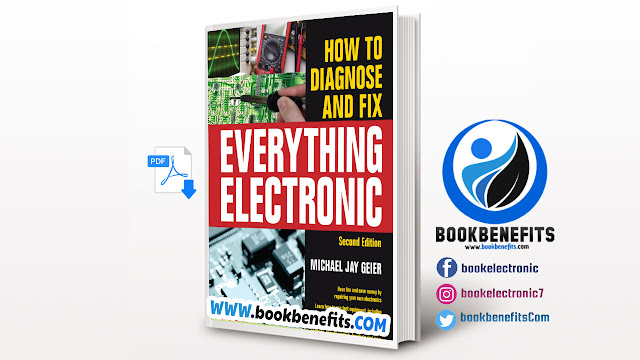Download How to Diagnose and Fix Everything Electronic PDF
How to Diagnose and Fix Everything Electronic PDF
Picture Of The Book :
About Of The Book :
EIntroduction everything. That’s a scary word, one I almost avoided including in the title.
Can any book cover everything about a topic? Yes and no. Yes, in
the sense that the principles and techniques you’ll learn can be applied to the
repair of every kind of consumer electronics device presently being made or
likely to be sold shortly. No, in that it’s impossible to fit each of the
thousands of types of components and countless varieties of gadgets in the world
into one volume. Covering all of them in the deepest detail would take a library and
a good-sized one at that.
The focus of this book is on today’s electronics, most of which are digital in
nature, and the kinds of problems you’re most likely to encounter. In this second
edition, we’ll explore some newly affordable test gear, look at ubiquitous
products that weren’t so commonplace just a few years ago cover new problems
cropping up in many recent gadgets, explore automotive-related issues, go
deeper into flat-panel TVs, and add helpful repair techniques and habits for more
parts and devices, including condenser mics, lithium batteries, headsets and
remote controls. The Glossary has lots of new goodies too.
It might seem like there isn’t that much one can serve in modern digital
gear, compared to the older analog circuitry. Dense boards populated by rows of
chips with leads too close together even to poke at with a test probe don’t seem
like good repair candidates, do they? Luckily, those areas aren’t where most
failures occur, and there’s still plenty of accessible circuitry to work on!
Some common problems in today’s gear were rare or nonexistent in earlier
technology, and they’re quite reparable.
Exotic and very obsolete components and their associated products aren’t
covered in this book. Electron tubes, once the mainstay of all electronics, are
pretty much gone, so we won’t spend time on their peculiarities and specific
troubleshooting methods. If you want to repair tube-type guitar amplifiers, you
can find books dedicated to them. Similarly, we won’t be discussing microwave
ovens, which also have tubes, or transmitting amplifiers of the sort used by
amateur radio operators. Nor will we take more than a passing glance at the cathode-
ray-tube (CRT, or picture tube)–based TVs and monitors. The CRT had a good,
long run, from the 1940s until just a few years ago, but it’s a dead technology,
thoroughly supplanted by flat-panel displays. Servicing CRT sets is rather
dangerous, so please find a book devoted to them if you have an interest in, say,
restoring antique TVs. What’s covered here is relevant but not comprehensive
enough regarding that topic to keep you safe around those high-voltage beasts.
Some obsolete technology is still in common use and may remain so for at
least a few more years, so we’ll explore it. Tape-based video recording continues
to be used in some digital camcorders, especially at the professional and
“prosumer” levels. VCRs and analog camcorders, which are rapidly
disappearing as high-definition TV (HDTV) obsolete them, maybe the only
key to the recovery of precious home movies yet to be transferred to digital media.
Serious audio devotees treasure their analog tape recorders and turntables and
will never replace them with CD or MP3 players. We won’t spend much time on
the old formats, but the troubleshooting techniques covered here apply
to their repair.
Most of today’s digital equipment still contains analog circuitry for audio or
video output, microphone input, voltage regulation, and such. Many home theater
receivers use analog amplifier stages and may have old-fashioned, linear power
supplies as well because they’re electrically quieter than newer, pulse-driven
designs. The best audiophile-grade stereo gear is pretty much all analog
and likely will remain that way. Even some digital radio and TV receivers use
analog stages to amplify and separate incoming signals before digital decoders
extract the data. So, troubleshooting techniques specific to analog circuitry are
far from antiquated; they continue to be relevant in our digital era.
In this book, it is assumed that you have probably opened an electronic device
at one time or another and checked a fuse. Perhaps you know a resistor when
you see one, and maybe you’ve even soldered or done some basic
troubleshooting. Still, we’re going to start from the top, ensuring you’re a sound
swimmer before diving into the deep end. And dive we will! Beginning with a
look at the tools you’ll need, we’ll explore setting up your home workshop.
We’ll discuss the best types of workbenches and lamps, and where to put your
gear and tools. We’ll take a close look at the most useful test instruments, where
to find bargains on them, and how to operate them. Getting good with an
oscilloscope is key to being a crack-shot tech, so we’ll explore a scope’s
operation in detail, button by button.
Contents Of The Book :
Chapter 1 Prepare for Blastoff: Fixing Is Fun!
Chapter 2 Setting Up Shop: Tools of the Trade
Chapter 3 Danger, Danger! Staying Safe
Chapter 4 I Fix, Therefore I Am: The Philosophy of Troubleshooting
Chapter 5 Naming Names: Important Terms, Concepts and Building Blocks
Chapter 6 Working Your Weapons: Using Test Equipment
Chapter 7 What Little Gizmos Are Made of: Components
Chapter 8 Road Maps and Street Signs: Diagrams
Chapter 9 Entering Without Breaking: Getting Inside
Chapter 10 What the Heck Is That? Recognizing Major Features
Chapter 11 A-Hunting We Will Go: Signal Tracing and Diagnosis
Chapter 12 Presto Change-O: Circuit Boards and Replacing Components
Chapter 13 That’s a Wrap: Reverse-Order Reassembly
Chapter 14 Pesky Parts and Persnickety Problems
Chapter 15 Aces Up Your Sleeve: Tips and Tricks for Specific Circuits and Products
Information Of The Book :
Title: How to Diagnose and Fix Everything Electronic
Language: English.
Size: 12,35 Mb.
Pages: 523
Year : 2015
Format: PDF.
Author: Michael Jay Geier

